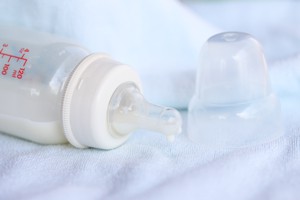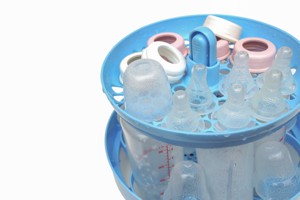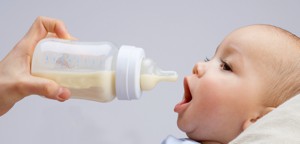 If you decide not to breastfeed, or find that you are unable to do so, then infant formula is the next best alternative for your baby. Whilst most formula is made from cow’s milk, specifically the whey, unlike cow’s milk it also includes all the vitamins and other nutrients your baby needs, and is easier to digest, which is why you should give your baby formula as an alternative to breastmilk, and not cow’s milk.
If you decide not to breastfeed, or find that you are unable to do so, then infant formula is the next best alternative for your baby. Whilst most formula is made from cow’s milk, specifically the whey, unlike cow’s milk it also includes all the vitamins and other nutrients your baby needs, and is easier to digest, which is why you should give your baby formula as an alternative to breastmilk, and not cow’s milk.
Types of Formula
There are various types of formula available, most can be purchased from supermarkets and other shops, whilst some are only available over the counter. Most brands also offer both a powdered version that has to be prepared before use, and a pre-mixed version that is sterile and ready to feed. The types of formula are:
- Stage One Formula / First Formula – This is a whey based formula that is designed to be suitable from birth. There are various brands available and in the UK all brands must meet strict standards on nutritional value. These standards are in fact so strict that there is very little difference between brands, although some parents do report that their child seems to fare better on a particular brand. This formula is suitable until your baby is ready to be weaned from formula milk.
- Stage Two / Casein Formula / Hungry Baby Formula – This formula has more casein (curds) from the cow’s milk than stage one formula, and manufacturers claim that it fills up babies for longer and helps them to sleep better, though the evidence to support this is questionable. As casein is harder to digest, it should not be given to babies younger than three months.
- Stage Three / Follow On Milk – This formula is also based on casein and is marketed as being suitable for baby’s for six months and older. There is little evidence of it having any nutritional benefit over Stage One or Stage Two formula, and there is some criticism that this is a product that allows formula manufacturers to get around strict advertising rules in the UK that prevent advertising of formula for babies younger than six months. However, it is often cheaper than Stage One milk.
- Growing Up Milk – This is formula aimed at toddlers and children aged one year and up, and contains a mixture of vitamins in addition to the milk. However, children aged one and up can be given cow’s milk and there is little evidence that this type of formula has any nutritional advantage over cow’s milk and a multi-vitamin supplement, which is considerably cheaper.
- Night Time Milk – This is milk that has cereal added to it, making it thicker and harder to digest. Manufacturers claim that it helps the baby to sleep longer at night as they feel less hungry, though there is little evidence to support this claim and it is also worth noting that it is very common for babies and toddlers to continue having night time awakenings for the first few years of their life.
- Anti-Reflux Formula – This formula is designed for babies who struggle with reflux. Whilst some spit up is normal, some babies suffer from discomfort as a result of lots of milk being regurgitated. Anti-reflux milk is suitable from birth and has thickeners that make it more likely to stay in the stomach. It is best to discuss your concerns with a GP or health visitor before switching to this milk.
- Comfort Formula – This formula has a reduced amount of lactose and is aimed at babies who suffer from colic and constipation. The manufacturers claim that it is easier to digest than regular formula and therefore may relieve the discomfort caused by these conditions.
- Soy-Based Formula – These formulas were previously prescribed for babies with cow’s milk allergies, but in more recent years formulas with fully hydrolysed proteins have been prescribed instead, as babies with a cow’s milk allergy are also often allergic to soy. You should not give your baby a soy based formula unless you have been advised to do so by a doctor.
- Formula With Fully Hydrolysed Proteins – These are formulas that whilst based on cow’s milk, have had the proteins broken down significantly and are therefore less likely to cause an allergic reaction in babies with a cow’s milk allergy. They should only be used if you have been advised to do so by a doctor.
What Equipment Do I Need For Bottle-Feeding
 If you are planning on formula feeding, then there is a small range of equipment that you will need to purchase. You might find it better value for money to buy a starter kit that includes everything you need.
If you are planning on formula feeding, then there is a small range of equipment that you will need to purchase. You might find it better value for money to buy a starter kit that includes everything you need.
Bottles
You will find it easier if you have more than one bottle and teat, especially in the early days of your baby’s life, when he or she may be feeding every couple of hours. There are lots of different types of bottles available, and you might find that some are easier to clean than others.
Some manufacturers offer two different sizes of bottle, usually a 150ml bottle and a 250ml bottle. As your baby grows, he or she will need larger amounts of formula and, therefore, if you start with the smaller bottles, you will need to switch to larger bottles at a later stage.
Teats
Teats tend to be designed to specifically fit that particular brand of bottle, and if you try and use the wrong branded teat in a bottle you may find that it leaks or doesn’t fit at all. Teats also have different speeds, typically, slow, medium, fast, and “variflow”.
New-borns should be started with a slow teat, whereas older babies will prefer a fast teat. Variflow teats are claimed to mimic breast-feeding much more as the flow is dependent on how much your baby sucks, and their suitability from birth depends on the manufacturer.
When Should I Change To A Fast Flow Teat?
Manufacturers generally state that medium teats should be used from three months plus, and fast teats should be used from six months plus, however, your baby may be ready for a change a few weeks before or after this age. Signs that your baby is ready to change include becoming fussier at the bottle, taking longer over feeds, and falling asleep during feeds. Your baby may also develop more wind as a result of increased sucking to get at more milk.
Sterilising Equipment
As your baby’s immune system is still developing, it’s important to sterilise any bottles and teats you use before each use, to prevent your baby developing illness from any of the bacteria, viruses and parasites that might be present on the feeding equipment. Obviously your baby is still going to pick up germs from other areas, but sterilising feeding equipment significantly reduces the risk of illness. The NHS recommends that you continue to sterilise bottle feeding equipment for each feed until your baby is one year old.
You can sterilise your baby’s bottles in a number of ways. These are:
- Steam – You can buy a bottle steriliser that either uses electricity or the microwave to create steam that sterilises the bottles and teats. Microwave steamers tend to take around three minutes to work, electric steamers take around ten minutes. Depending on the manufacturer, some steamers keep the items sterile for several hours.
- Cold Water – You can buy a special chemical that is safe to use to sterilise your baby’s equipment. It is available in both tablet and liquid form. You will also need a sterilising container to put the bottles and teats in. The solution is diluted in water and the bottles and teats are placed in the water. It takes around 30 minutes for the items to become sterile. You only need to change the solution every 24 hours and you can remove or add items as you need to.
- Boiling – You can boil your bottle feeding equipment to sterilise it, though it should be noted that repeated boiling will eventually damage the teats. You will need to place the items in a large pan of water and bring to the boil. The items should be boiled for ten minutes.
How To Prepare Baby Formula
If you are using pre-mixed formula, then make sure you wash your hands thoroughly and then pour the formula into a pre-sterilised bottle. If your baby prefers it warm, you can heat it up by placing the bottle into a small container with boiled water. Do not use the microwave to heat your baby’s milk, as hot spots can occur that can burn your baby’s tongue. Check the temperature of the milk by dropping a small amount on the back of your hand.
If you are using powdered formula, you need to be aware that the powder is not sterile and therefore you need to follow the instructions on the packaging carefully. Wash your hands before preparing the formula and use a pre-sterilised bottle. Follow the instructions on the packaging, and make sure you use the scoop that comes with the tin of powder that you are using. Do not overfill the scoop, as too much powder can lead to your baby becoming constipated. Too little powder in the scoop may result in your baby missing out on vital nutrients. Always use cooled boiled water to prepare the formula.
If you are travelling abroad to a place where tap water is not safe to drink, you can use bottled water providing it has a sodium (NA) content that is below 20mg per 100ml. Some brands of water will state whether or not they are suitable for babies but if not you will have to look at the sodium content (Mumblog Tip: Most French brands of bottled water are safe for using in formula and French parents are actively encouraged to use bottled water rather than tap water). You will still need to boil the water before use.
How Often Should I Feed My Baby With Formula?
 Most brands of formula will have a guide on the back informing you about how much milk your baby will need. However, it’s important to note that this is just a guide, and that your baby may consume more or less than the stated amount, and this is very normal.
Most brands of formula will have a guide on the back informing you about how much milk your baby will need. However, it’s important to note that this is just a guide, and that your baby may consume more or less than the stated amount, and this is very normal.
Furthermore, as with breastfeeding, the advice for formula feeding is to feed on demand, responding to your baby’s hunger cues. If your baby is hungry he will turn his head, open his mouth searching for a nipple, and possibly suck on his hands. He will start to become unsettled if he does not get fed.
Should I Add Baby Rice To The Formula?
Your own mother may have added baby rice cereal to your bottle when you were a baby, and in previous generations this was considered the norm. However, this is no longer recommended and in fact considered dangerous as your baby may choke on the milk. If you wish to buy a brand of milk with cereal added (i.e. night time milk) then this will be mixed correctly and not pose a choking risk.
However, this should only be used from six months onwards and there is no evidence to prove that it helps babies to sleep for longer. If your baby seems hungry during the day and is not old enough to be weaned, try increasing the amount of milk in their bottle. It’s very likely that he or she is going through a growth spurt and drinking increased amounts of milk during these times is normal.
Bottle Feeding Tips
- Your baby might become distracted during feeds. If this is the case try and find somewhere quiet and free of interruptions to feed them.
- If you have a gassy baby, then consider interrupting the feed after each 30ml has been drunk to burp him before returning him to the bottle, as this will prevent too much gas building up.
- Make sure you hold the bottle in a way that ensures the teat is completely filled with milk. This will prevent your baby from taking in too much air and then developing gas.
- If the teat collapses during feeding, or the bottle starts leaking, then it is likely that the teat is not placed in the holder correctly.
- Throw out any unused formula, you must not save it for later feeds as bacteria can quickly grow in the mixture.
- If you are out for the day and need to take feeds, then it’s best to be able to prepare them as you need, with a vacuum flask filled with boiled water. You can buy small containers that can be filled with a measured amount of formula ready for you to tip into the bottle as needed. After you have sterilised the bottle, put it together with the lid to keep the teat and the inside of the bottle sterile.
